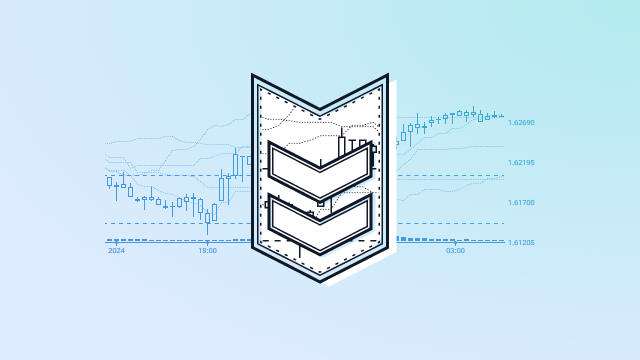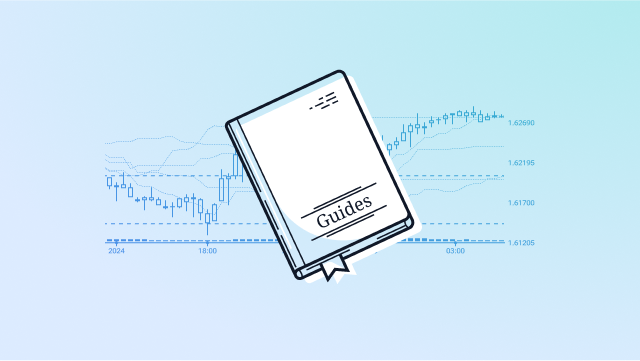We gathered 20 popular indicators used for Forex markets and described all the necessary information you will need to know about them in this article.
Each indicator is described in detail. By using this white paper, you will learn:
1) important facts about the indicator;
2) its working method
3) which settings perform better for this particular indicator;
4) possible ways to use them in technical analysis;
5) our additional suggestions and remarks;
6) list of the best forex trading indicators
Top 21 Forex Technical Indicators List
1. Awesome Oscillator
Histogram of the 5- and 34-period median-price SMAs. Awesome Oscillator is used for zero-line crosses, twin peaks, and saucer setups in momentum trades.
2. Alligator
Three smoothed MAs (jaw, teeth, lips) that “sleep” during ranges and “eat” during trends. Traders watch the Alligator lines opening for breakout entries.
3. Renko Bars
Time-independent bricks that print only after a fixed price move. Renko Bars are ideal for trend-following systems that need noise filtered out.
4. Polarized Fractal Efficiency
Polarized Fractal Efficiency scores how directly price moves from A to B. High absolute values favor trend plays; near zero favors mean-reversion.
5. Moving Average (MA) Crossover
Fast EMA crossing a slow EMA. Classic Moving Average Crossover trend-entry and exit signal; works best in clean directional markets.
6. Force Index
Volume-weighted price change. Force Index confirms breakout strength and flags real buying or selling pressure.
7. Moving Average of Oscillator
MACD minus its signal line. Divergence between OsMA and price often foreshadows reversals.
8. Relative Vigor Index (RVI)
Compares close vs. open across bars, oscillating around zero. RVI is used to confirm trend direction and spot divergence.
9. Money Flow Index
RSI adjusted for volume. Spots overbought/oversold and detects “smart-money” inflows or outflows.
10. Williams Percent Range Indicator
Momentum oscillator showing close relative to recent high-low. Good for timing pullbacks in ranging or trending setups.
11. Market Facilitation Index
Price change per tick volume; color codes show whether money and conviction back the move. This index guides continuation vs. fade decisions.
12. Moving Average Convergence/Divergence
EMA spread plus signal line and histogram. Traders look for line crosses, zero crossings, and histogram shifts to ride trends or catch reversals.
13. Commodity Channel Index
Commodity Channel Index is a deviation from a moving average. Breaks above +100 or below –100 cue trend trades or overextended fades.
14. Heiken Ashi
Averaged candles that smooth wicks and gaps. Heiken Ashi keeps traders in trends longer and filters minor pullbacks.
15. Traders Dynamics Index
RSI, Bollinger Bands, and signal lines in one pane. TDI indicator is popular in swing systems for confirming direction and volatility.
16. Gator Oscillator
Difference between Alligator lines plotted as dual histograms. Gator shows trend awakening, feeding, and exhaustion phases.
17. Demarker Indicator
Compares intrabar highs and lows to gauge demand. Demarker values above 0.7 or below 0.3 mark potential climax zones.
18. Ichimoku Kinko Hyo
Five lines plus cloud give trend, momentum, and support/resistance in one glance. Ichimoku Kinko Hyo i used for breakout and pullback trading.
19. Accelerator Decelerator
Awesome Oscillator minus its SMA; measures momentum acceleration. Early warning for slowing trends or pending turns.
20. Zig Zag
Plots swings only after a fixed % move, ignoring minor noise. Zig Zag helps map Elliott waves and draw fib retracements.
21. Bollinger Bands
SMA with ±2 standard-deviation envelopes. Traders fade Bollinger Bands extremes in ranges and trade band expansions for breakouts.
Free Tool to Backtest Your Forex Trading Strategies With Different Indicators
Forex Tester Online supports all major indicators, and even more (including the custom ones). This is a perfect place to backtest your strategies, gain skill and confidence.
Learn and practice without risking real money on Forex Tester Online trading simulator:
What Are Indicators in Forex?
Before diving into our list of the best indicators in Forex, let’s clarify what they are. They are statistical tools that analyze price movements and trading volume in the currency market. They play a crucial role in helping traders identify trends, reversals, and potential entry and exit points.
Categories of Forex Indicators
Trend
Show the market’s dominant direction, smoothing out noise. Think of them as the compass. Classic examples: Moving Averages (SMA, EMA), Ichimoku Cloud, and Parabolic SAR. They help traders ride sustained moves instead of guessing tops and bottoms.
Momentum
Measure the speed of price changes—how hard the market is pressing the gas pedal. Popular tools include Relative Strength Index (RSI), Moving Average Convergence Divergence (MACD), and Stochastic Oscillator. They flag overbought or oversold states, alerting traders to potential reversals or breakouts.
Volume
Track the number of ticks or actual contracts traded, revealing conviction behind a move. On-Balance Volume (OBV), Volume-Weighted Average Price (VWAP), and Chaikin Money Flow (CMF) expose whether big players are accumulating or distributing, confirming or rejecting price action.
Volatility
Gauge how far prices may swing. They’re the market’s seismograph. Bollinger Bands, Average True Range (ATR), and Donchian Channels expand and contract with changing turbulence, guiding stop-loss placement and position sizing.
Which Indicator Is the Best For Forex Trading?
Selecting the right Forex market indicators depends on your trading style, experience level, and current market conditions. Here are some tips to help you make the best choice:
-
Start small. Try one or two basics like RSI or Moving Averages.
-
Stay light. Too many tools give mixed signals and slow decisions.
-
Test first. Use a backtesting tool or demo account, keep what works, drop what doesn’t.
They help interpret market signals for entry points, optimal stop order placement, and exit strategies. While using multiple indicators simultaneously can be beneficial, they often serve similar purposes. Overloading can lead to analysis paralysis and potentially unfavorable trading outcomes. Therefore, it’s important to make sure that the quantity of indicators used enhances the quality of decision-making towards achieving your trading objectives.
FAQ
Do I Even Need Indicators for Forex Trading?
While you don’t necessarily need them to trade forex, they can improve your technical analysis and help you make more informed decisions.
What is the Most Accurate Indicator for Forex?
The Moving Average Convergence Divergence (MACD) is often regarded as one of the most accurate one for forex trading. Its combination of trend-following and momentum data makes it highly reliable across different market conditions.
However, the accuracy of any indicator also depends on your understanding and how well you use it in conjunction with other tools.
What If I Rely Only on Forex Indicators for Trading?
While they are powerful tools, it’s not advisable to rely solely on them. They should be used alongside other forms of analysis, such as price action and market news, to make well-informed trading decisions.
How Often to Adjust Them?
You should adjust your indicator for forex trading as needed based on market conditions and your trading strategy.
Regularly review their performance and make adjustments to improve their accuracy.
 Backtest Trading Strategy with Indicators
Backtest Trading Strategy with Indicators
 ไทย
ไทย
 Tiếng Việt
Tiếng Việt
 Polski
Polski
 Türkçe
Türkçe
 Nederlands
Nederlands
 Română
Română
 한국어
한국어
 Svenska
Svenska


